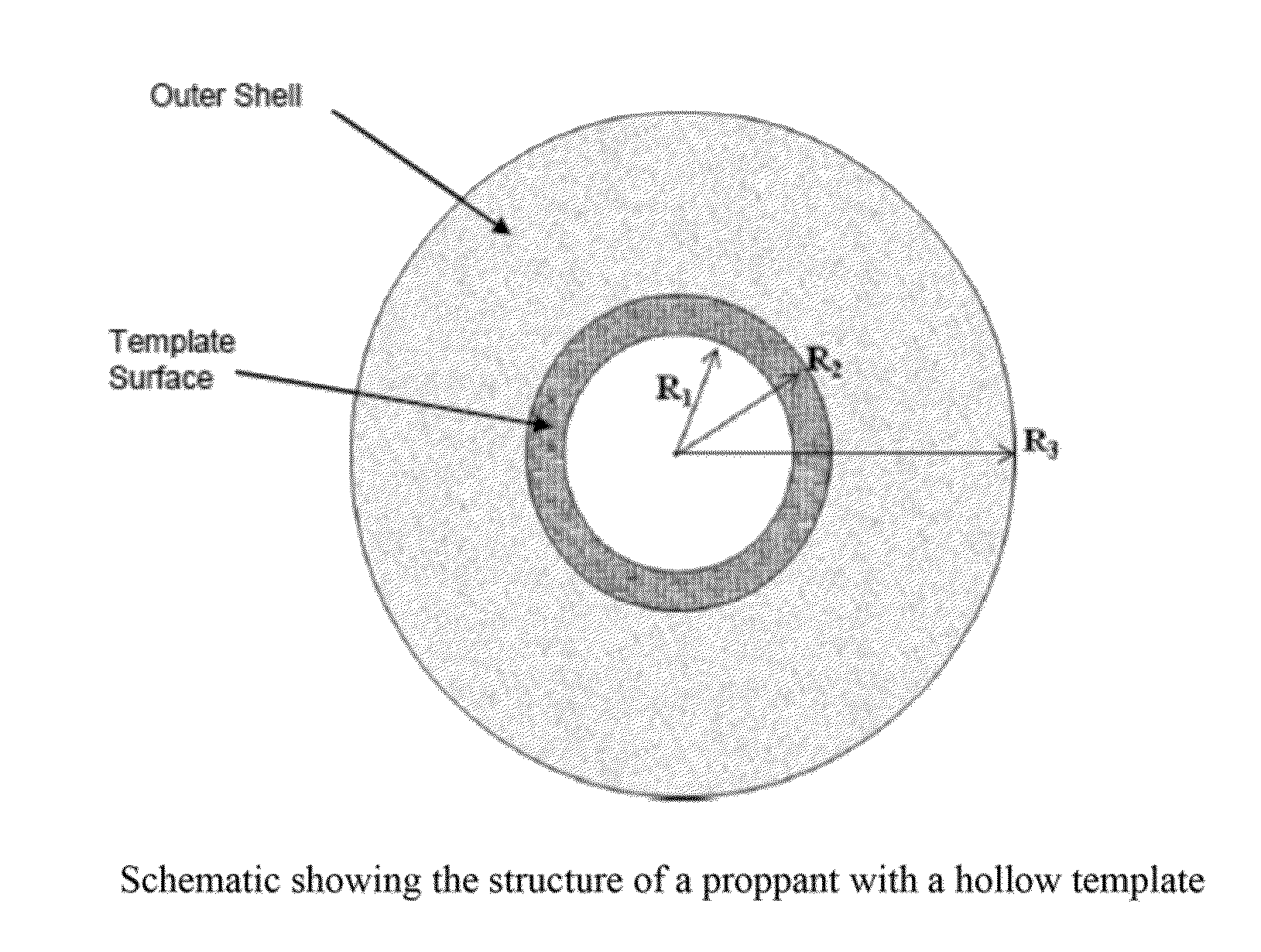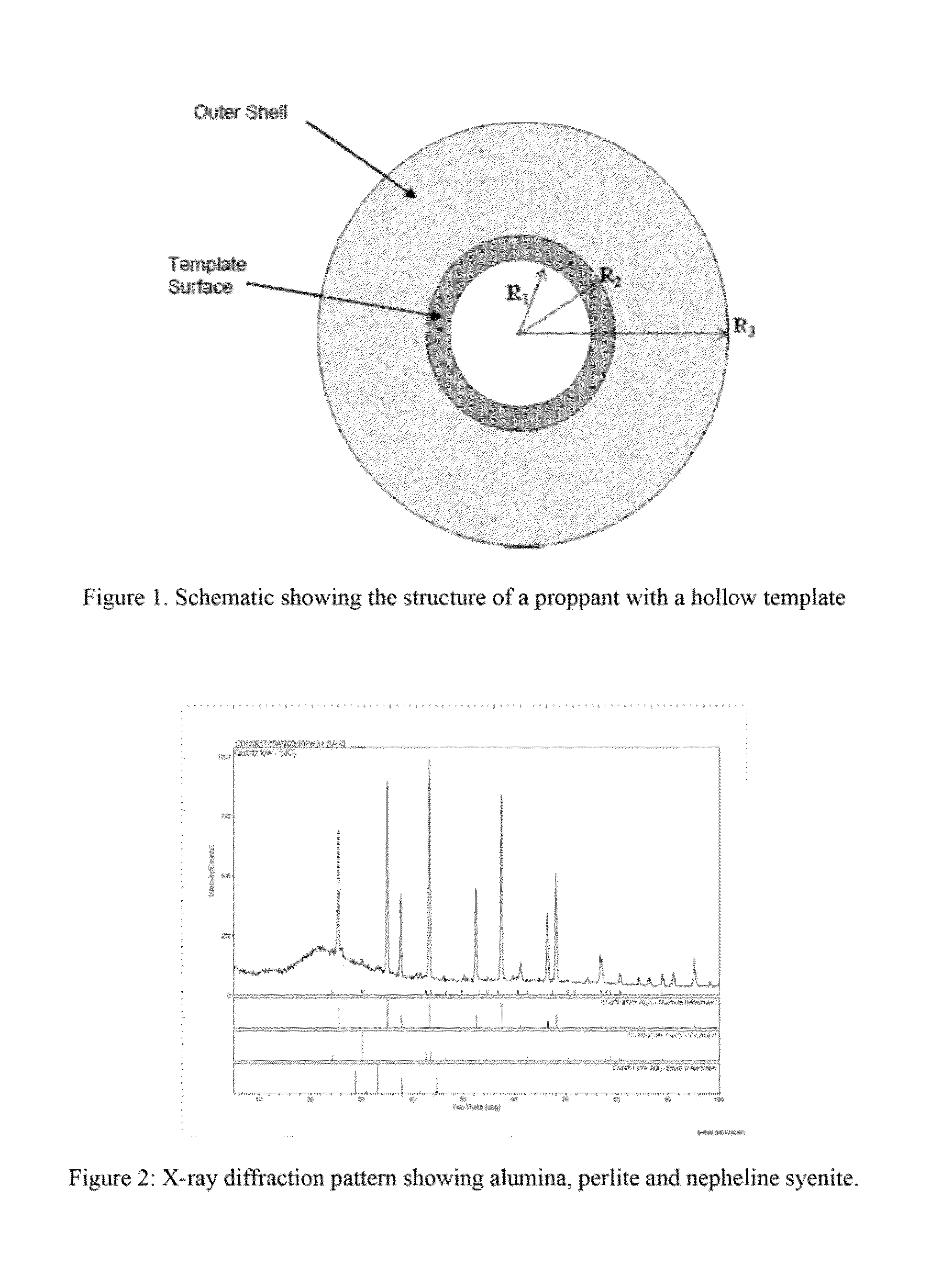Light Weight Proppant With Improved Strength And Methods Of Making Same
a technology of glassceramic composites and light weight, applied in the direction of sealing/packing, wellbore/well accessories, ceramicware, etc., can solve the problems of high cost and light weight of sand, extreme density of conventional proppants, and low strength of resin-coated sands, etc., to achieve high strength and toughness, reduce density, and improve strength
- Summary
- Abstract
- Description
- Claims
- Application Information
AI Technical Summary
Benefits of technology
Problems solved by technology
Method used
Image
Examples
example 1
[0324]Example 1 is a proppant formulation containing alumina, perlite, and nepheline syenite. Traditional ceramic processing (powder blending, pressing / spraying, and sintering) was used to make the proppants. The raw, unexpanded perlite powder (Grade #270, Hess Pumice Products, 100 Hess Dr. Malad City, Id. 83252) with initial particle size of 44 μm (−325 mesh), along with alumina powder (Grade AC-300 Ungrounded, Aluchem, 14782 Beaver Pike, Jackson, Ohio 45640) and nepheline syenite powder (Grade A270, Trinity Ceramic Supply Inc., 9016 Diplomacy Row Dallas Tex. 75247) were attrition-milled in water for 0.5 h-5 h to reach final average particle size around 1.50 μm. The following additives were also employed in the slurry. 0.5%-1.5% CERAFIX K33 (ZSCHIMMER & SCHWARZ, 70 GA Highway 22W, Milledgeville, Ga. 31061), 0.3%-0.7% DOLAPIX CE64 (ZSCHIMMER & SCHWARZ, 70 GA Highway 22W, Milledgeville, Ga. 31061), 5%-10% Ball clay (Old Hickory #1 Glaze Clay, Trinity Ceramic Supply Inc., 9016 Diploma...
example 2
[0327]Example 2 is a proppant formulation of alumina, perlite, and nepheline syenite components and also including ground cenospheres (described above as an optional ingredient). Traditional ceramic processing (powder blending, pressing / spraying, and sintering) was used to make the proppants. The raw, unexpanded perlite powder (Grade #270, Hess Pumice Products, 100 Hess Dr. Malad City, Id. 83252) with an initial particle size of 44 μm (−325 mesh), along with alumina powder (Grade AC-300 Ungrounded, Aluchem, 14782 Beaver Pike, Jackson, Ohio 45640) and nepheline syenite powder (Grade A270, Trinity Ceramic Supply Inc., 9016 Diplomacy Row Dallas Tex. 75247) were attrition-milled in water for 0.5 h-5 h to reach a final average particle size of around 1.50 μm. The following additives were also employed in the slurry. 0.5%-1.5% CERAFIX K33 (ZSCHIMMER & SCHWARZ, 70 GA Highway 22W, Milledgeville, Ga. 31061), 0.3%-0.7% DOLAPIX CE64 (ZSCHIMMER & SCHWARZ, 70 GA Highway 22W, Milledgeville, Ga. 3...
PUM
| Property | Measurement | Unit |
|---|---|---|
| median particle size | aaaaa | aaaaa |
| diameter | aaaaa | aaaaa |
| Krumbein sphericity | aaaaa | aaaaa |
Abstract
Description
Claims
Application Information
 Login to View More
Login to View More - R&D
- Intellectual Property
- Life Sciences
- Materials
- Tech Scout
- Unparalleled Data Quality
- Higher Quality Content
- 60% Fewer Hallucinations
Browse by: Latest US Patents, China's latest patents, Technical Efficacy Thesaurus, Application Domain, Technology Topic, Popular Technical Reports.
© 2025 PatSnap. All rights reserved.Legal|Privacy policy|Modern Slavery Act Transparency Statement|Sitemap|About US| Contact US: help@patsnap.com



